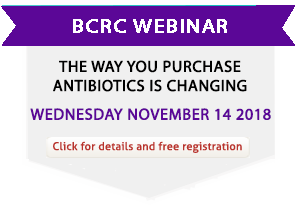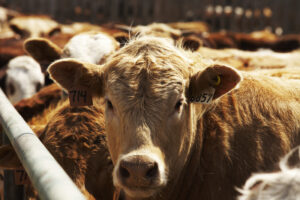Antibiotic Use in Canadian Feedlots
Remarque : cette page web n’est actuellement disponible qu’en anglais.
This article written by Dr. Reynold Bergen, BCRC Science Director, originally appeared in the October 22, 2018 issue of Canadian Cattlemen magazine and is reprinted on the BCRC Blog with permission of the publisher.
September’s column summarized a Beef Cluster project that evaluated antibiotic use in Western Canadian cow-calf operations. Nearly all cow-calf farms used antibiotics, but very few animals were treated, and most of the antibiotics used were not related to the antibiotics most commonly used in humans. But when it comes to antibiotic use in the beef industry, most of the attention is focused on the feedlot sector.
Until recently, the best Canadian feedlot antibiotic use information came from a small 2006 project (Antimicrobial Resistance in Escherichia coli Recovered from Feedlot Cattle and Associations with Antimicrobial Use, PLoS ONE 10: e0143995). Antibiotic use practices change over time, so a Beef Science Cluster 2 project updated and expanded this knowledge.
What they did:
A team of veterinarians with Feedlot Health Management Services in Okotoks, Alberta gathered, summarized and analyzed injectable and in-feed antibiotic use records from more than 2.6 million cattle placed in 36 feedlots between November 2008 and October 2012.
What they learned:
Nearly all feedlot cattle received antibiotics. Over 85% of the antibiotic doses given to feedlot cattle were ionophores, like Rumensin or Bovatec, that are not used to treat bacterial infections in humans. The rest of this column focuses on the roughly 15% of antibiotic doses that were related to antibiotics used in human medicine (medically important antibiotics, or MIA).
Injectable antibiotics (including the antibiotics that some growth implants contain to prevent abscessed ears) were given to 73% of cattle. But because most cattle only received antibiotic injections on a few occasions, injectable antibiotics accounted for only 17% of all MIA doses used in feedlot cattle. The vast majority of injectable antibiotic doses were given to prevent, control or treat respiratory disease. Cattle deemed high risk for bovine respiratory disease (BRD) were given antibiotics 95% of the time, while 59% of low risk cattle were given antibiotics. Average injectable MIA use per animal declined by 9% over the four-year study.
In-feed antibiotics were given to 97% of cattle. Because these antibiotics are given every day over a longer period of time, in-feed antibiotics accounted for 83% of MIA use in feedlot cattle. Almost half were used to prevent liver abscesses, 29% were used to control histophilosis, and the remaining 5% were used to treat outbreaks of footrot, pinkeye, etc. Unlike injectable antibiotic use, in-feed antibiotic use was similar between cattle of high vs. low BRD risk. Average in-feed antibiotic use per animal declined by 14% over the four-year study.
MIA can be further categorized as Very High, High or Medium Importance in human medicine. In this feedlot study, 87% of the MIA used were of Medium Importance. In contrast, data reported to the Public Health Agency of Canada indicate that Medium Importance antibiotics only account for 3% of the antibiotics sold for use in people.
What it means:
Nearly all feedlot cattle were exposed to antibiotics through feed, injection, or implants, but the vast majority of antibiotics used in feedlot production were ionophores (generally not used in human medicine) and when MIA were used in feedlot production, the majority were Medium Importance antibiotics that are seldom used in human medicine. Adding feedlot antibiotic use data to the Canadian Integrated Program for Antibiotic Resistance Surveillance (as is already done for poultry and swine) would allow us to monitor these antibiotic use patterns on an ongoing basis.
Antibiotic use in livestock has come under greater regulatory and media scrutiny in recent years. Upcoming changes to antibiotic access (described below) are intended to minimize the development of antibiotic resistance by reducing antibiotic use. The pressure to demonstrate responsible use will likely intensify in the coming years. For the reductions in feedlot antibiotic use reported in this study to continue, more effective non-antibiotic approaches to address liver abscess, histophilosis and bovine respiratory disease challenges will need to be developed and adopted.

As of December 1, all livestock producers will need to have a prescription from a veterinarian with whom they have a valid veterinary-client-patient relationship before they will be able to access any MIA. The key change for feedlot producers, most of whom already work closely with a veterinarian, will affect in-feed antibiotics. You will require a veterinary prescription before a feed mill will sell you complete feeds or premixes containing antibiotics. If this is news to you, or if you don’t already have regular contact with a veterinarian, start planning now! More information about these Health Canada changes are available at www.beefresearch.ca.
The Canadian Beef Cattle Check-Off has increased from $1 to $2.50 per head in most provinces, with approximately 75 cents allocated to the Beef Cattle Research Council. Canada’s National Beef Strategy outlined why the Check-Off increase was needed, and how it would be invested. One of the target outcomes under the strategy’s Beef Demand pillar is to communicate the role of responsible antibiotic stewardship in maintaining the effectiveness of human health products. This project generated important baseline antibiotic use data that our industry can use to reassure regulators, human health professionals and consumers that Canada’s feedlot sector is continuing to use antibiotics responsibly.
The Beef Research Cluster is funded by the Canadian Beef Cattle Check-Off and Agriculture and Agri-Food Canada with additional contributions from provincial beef industry groups and governments to advance research and technology transfer supporting the Canadian beef industry’s vision to be recognized as a preferred supplier of healthy, high quality beef, cattle and genetics.
Click here to subscribe to the BCRC Blog and receive email notifications when new content is posted.
The sharing or reprinting of BCRC Blog articles is typically welcome and encouraged, however this article requires permission of the original publisher.
We welcome your questions, comments and suggestions. Contact us directly or generate public discussion by posting your thoughts below.
